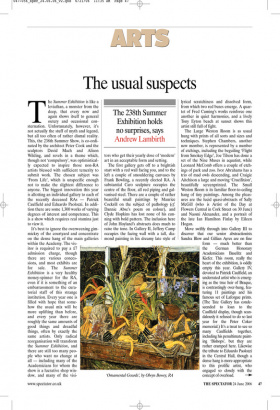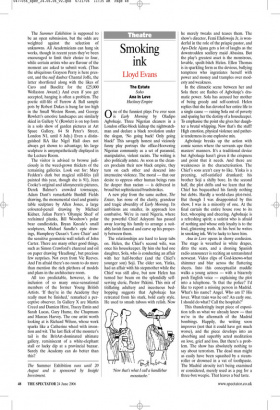The usual suspects
The 238th Summer Exhibition holds no surprises, says Andrew Lambirth
The Summer Exhibition is like a leviathan, a monster from the deep, that every now and again shows itself to general outcry and occasional consternation. Unfortunately, however, it’s not actually the stuff of myth and legend, but all too often of rather dismal reality. This, the 238th Summer Show, is co-ordinated by the architect Peter Cook and the sculptors David Mach and Alison Wilding, and revels in a theme which, though not ‘compulsory’, was optimistically expected to inspire those non-RA artists blessed with sufficient temerity to submit work. The chosen subject was ‘From Life’, which is unspecific enough not to make the slightest difference to anyone. The biggest innovation this year is allotting an individual gallery to each of the recently deceased RAs — Patrick Caulfield and Eduardo Paolozzi. In addition there are some 1,300 works of varying degrees of interest and competence. This is a show which requires real stamina just to view it.
It’s best to ignore the overweening gimmickry of the courtyard and concentrate on the dense hang of the main galleries within the Academy. The visitor is required to pay a £7 admission charge, though there are various concessions, and most exhibits are for sale. The Summer Exhibition is a very healthy money-spinner for the RA, even if it is something of an embarrassment to the curatorial staff of this strange institution. Every year one is filled with hope that somehow the usual mix will be more uplifting than before, and every year there are roughly the same amounts of good things and dreadful things, often by exactly the same artists. Only radical reorganisation will transform the Summer Exhibition, and there are still too many people who want no change at all — including many of the Academicians for whom the show is a lucrative shop window, and many of the visi tors who get their yearly dose of ‘modern’ art in an acceptable form and setting.
The first gallery gets off to a brightish start with a red wall facing you, and to the left a couple of smouldering canvases by Frank Bowling, a recently elected RA. A substantial Caro sculpture occupies the centre of the floor, all red piping and galvanised steel. There are a couple of rather beautiful small paintings by Maurice Cockrill on the subject of pathology (cf. Dannie Abse’s poem on colour), and Clyde Hopkins has lost none of his cunning with bold pattern. The inclusion here of John Hoyland’s abstracts does much to raise the tone. In Gallery II, Jeffery Camp occupies the facing wall with a tall, diamond painting in his dreamy late style of lyrical scratchiness and dissolved form, from which two red buses emerge. A quartet of Fred Cuming’s works reinforce one another in quiet harmonies, and a lively Tony Eyton beach at sunset shows this artist still full of fight.
The Large Weston Room is as usual hung with prints of all sorts and sizes and techniques. Stephen Chambers, another new member, is represented by a number of etchings, including the beguiling ‘Flight from Smokey Edge’, Joe Tilson has done a set of the Nine Muses in aquatint, while Leonard McComb offers a couple of etchings of park and zoo. Ivor Abrahams has a trio of mad owls descending, and Craigie Aitchison a large and moving ‘Crucifixion’, beautifully screenprinted. The Small Weston Room is its familiar floor-to-ceiling hang of tiny paintings. Among the pleasures are the lucid quasi-abstracts of Sally McGill (who is Artist of the Day at Flowers Central in Cork Street on 30 June) and Naomi Alexander, and a portrait of the late Ian Hamilton Finlay by Eileen Hogan.
Move swiftly through into Gallery III to discover that our senior abstractionists Sandra Blow and Gillian Ayres are on fine form — much better than the German Honorary Academicians Baselitz and Kiefer. This room, really the heart of the exhibition, is oddly empty this year. Gallery IV, devoted to Patrick Caulfield, an underrated artist who is emerging as the true heir of Braque, is contrastingly over-hung, featuring 11 paintings and his famous set of Laforgue prints. (The Tate Gallery has condescended to loan to the Caulfield display, though scandalously it refused to do so last year for the Peter Coker memorial.) It’s a treat to see so many Caulfields together, including his penultimate painting ‘Bishops’, but they are rather cramped here. Likewise the tribute to Eduardo Paolozzi in the Central Hall, though a dense hang is more appropriate to this prolific artist, who engaged so closely with the concept of overload. The Summer Exhibition is supposed to be an open submission, but the odds are weighted against the selection of unknowns. All Academicians can hang six works, though in recent years they’ve been encouraged to limit their choice to four, while certain artists who are flavour of the moment are asked to submit work. (Thus the ubiquitous Grayson Perry is here present, and the naif dauber Chantal Joffe, the latter shortlisted along with the likes of Caro and Baselitz for the £25,000 Wollaston Award.) And even if you get accepted, hanging is often a problem. The poetic still-life of Farrow & Ball sample pots by Robert Dukes is hung far too high in the Small Weston Room, and George Rowlett’s emotive landscapes are similarly skied in Gallery V. (Rowlett is on top form in a solo show of garden pictures at Art Space Gallery, 84 St Peter’s Street, London N1, until 8 July.) Even a distinguished RA like Nigel Hall does not always get shown to advantage; his large sculpture is unsympathetically displayed in the Lecture Room.
The visitor is advised to browse judiciously in the weed-grown thickets of the remaining galleries. Look out for: Mary Fedden’s dark but magical still-lifes (all painted this year, though she is 91), Jean Cooke’s original and idiosyncratic pictures, Derek Balmer’s crowded townscape, Adam Dant’s remarkable Bunhill Fields drawing, the monumental steel and granite table sculpture by Allen Jones, a large coloured-pencil drawing by Michael Kidner, Julian Perry’s ‘Olympic Shed’ of reclaimed planks, Bill Woodrow’s polar bear candlesticks, Bryan Kneale’s small sculptures, Michael Sandle’s epic drawings, Humphrey Ocean’s ‘Love Chair’ and the sensitive geometric wall reliefs of John Carter. There are many other good things, such as Simon Crawford’s charcoal and oil on paper drawing ‘Headlong’, but precious few surprises. Not even from Vic Reeves. And I’m afraid there’s no room to do more than mention the rich plethora of models and plans in the architecture room.
All too predictable, however, is the inclusion of so many once-sensational members of the former Young British Artists. ‘If they’re in the Academy they really must be finished,’ remarked a perceptive observer. In Gallery X are Martin Creed and Damien Hirst, Tracey Emin and Sarah Lucas, Gary Hume, the Chapmans and Marcus Harvey. The one artist worth looking at is Richard Wilson, whose work sparks like a Catherine wheel with invention and wit. The last flick of the monster’s tail is the BritArt-dominated ultimate gallery, reminiscent of a white-elephant stall or lucky dip at a provincial bazaar. Surely the Academy can do better than this?




















































 Previous page
Previous page